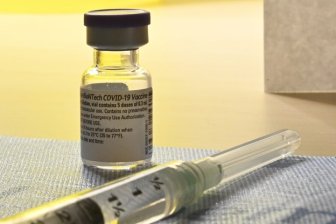Science
A Canadian astronaut will be on NASA’s Artemis deep space lunar orbit – Global News

One Canadian astronaut will be joining a record-setting voyage into deep space around the moon in the second phase of NASA’s Artemis program, expected to launch in 2023.
The major new public-private space program has the ambitious goal of taking humans back to the lunar surface — including the first woman to land on the moon — and keeping them there.
Innovation Minister Navdeep Bains made the announcement on Wednesday, saying the Canadian and American governments have signed a new treaty outlining Canadian participation in the Artemis missions and locking in a seat for a Canadian astronaut on the 2023 launch.
That agreement will make Canada the second country in history to have an astronaut travel into deep space and fly around the moon, and also locks in a second flight for a Canadian to the Lunar Gateway station which is still yet to be built.
In an interview with Global News, Bains said he also isn’t ruling out the possibility of getting Canadians on future missions as well, including potentially the Artemis III moon landing voyage.
“I won’t close the door on that. We’re still fairly optimistic. We want to continue to build on the momentum that we have when it comes to the investments we made in our space program,” he said.
“I’m very excited and over the moon.”
The Canadian government has pledged $1.9 billion to the Lunar Gateway project, which Bains said includes the cost of the seats on the Artemis II mission and to the Lunar Gateway itself.
The Canadian Space Agency has four active Canadian astronauts working at NASA’s Johnson Space Center: Jeremy Hansen, Joshua Kutryk, Jennifer Sidey-Gibbons and David Saint-Jacques.
“I’m very excited about the opportunities that lie ahead for Canada,” said Jeremy Hansen in a discussion among the astronauts that took place along with the announcement.
Hansen compared the mission’s significance with the Apollo 8 mission.
“This time when we return to the moon, our eyes are fixed back on our planet and the challenges that face us here,” he said, emphasizing the huge amount of collaboration involved in the missions.
“That same collaboration is needed as we tackle big global challenges like climate change.”
Jennifer Sidey-Gibbons also emphasized the scientific potential of the missions.
She said research on water and ice distribution on the moon, as well as being able to study implications of space environments for medical research and environmental science, will play a key part in helping shape the way forward towards travel further into the solar system.
“It means Canadians will be there to help facilitate all that future science,” she said.
“It’s wonderful Canada gets to be part of the most exciting part of this new venture.”
Bains added the voyages will offer “enormous opportunities” for Canadians to do cutting edge research and science on two key issues.
“The two areas that we will focus on is the environment and looking at the impact of climate change on the Earth’s atmosphere, as well as biomedical technologies,” he said.
“Now, more than ever with COVID-19, we know how important it is to look at cutting edge research when it comes to the health care challenges that we’re facing.”
READ MORE: Canada poised to unveil ‘significant’ role in upcoming NASA Artemis lunar mission
NASA put the first men on the moon in the 1960s and 1970s but hasn’t returned since.
The American space shuttle program collapsed in 2011 in the wake of the Challenger and Columbia disasters, and a lack of sustained funding for the program and its shuttles.

However, an injection of money and technology from the private sector, as well as renewed political and strategic interest in space exploration, has spurred a major revival in recent years.
The Artemis missions have three core phases: Artemis I, Artemis II and Artemis III.
Artemis I will be an uncrewed maiden flight of the new Space Launch System and the Orion orbiter.
Artemis II, which will include a Canadian astronaut, will be the first crewed test flight of the system and orbiter, lasting 10 days and setting a new record for the farthest human travel from the Earth as four astronauts circle the moon twice before returning to land.
Artemis III, expected to take place in 2024, will launch the first woman and next man to the surface of the moon using a new lunar landing system.
Lisa Campbell, president of the Canadian Space Agency, said the country has a “strong core” of astronauts ready to join the mission, but that there is no decision yet on who will be on the missions.

© 2020 Global News, a division of Corus Entertainment Inc.
Science
SpaceX sends 23 Starlink satellites into low-Earth orbit


|
|
April 23 (UPI) — SpaceX launched 23 Starlink satellites into low-Earth orbit Tuesday evening from Space Launch Complex 40 at Cape Canaveral Space Force Station in Florida.
Liftoff occurred at 6:17 EDT with a SpaceX Falcon 9 rocket sending the payload of 23 Starlink satellites into orbit.
The Falcon 9 rocket’s first-stage booster landed on an autonomous drone ship in the Atlantic Ocean after separating from the rocket’s second stage and its payload.
The entire mission was scheduled to take about an hour and 5 minutes to complete from launch to satellite deployment.
The mission was the ninth flight for the first-stage booster that previously completed five Starlink satellite-deployment missions and three other missions.





Science
NASA Celebrates As 1977’s Voyager 1 Phones Home At Last


|
|
Voyager 1 has finally returned usable data to NASA from outside the solar system after five months offline.
Launched in 1977 and now in its 46th year, the probe has been suffering from communication issues since November 14. The same thing also happened in 2022. However, this week, NASA said that engineers were finally able to get usable data about the health and status of its onboard engineering systems.
Slow Work
Fixing Voyager 1 has been slow work. It’s currently over 15 billion miles (24 billion kilometers) from Earth, which means a radio message takes about 22.5 hours to reach it—and the same again to receive an answer.
The problem appears to have been its flight data subsystem, one of one of the spacecraft’s three onboard computers. Its job is to package the science and engineering data before it’s sent to Earth. Since the computer chip that stores its memory and some of its code is broken, engineers had to re-insert that code into a new location.
Next up for engineers at NASA’s Jet Propulsion Laboratory in California is to adjust other parts of the FDS software so Voyager 1 can return to sending science data.
Beyond The ‘Heliopause’
The longest-running and most distant spacecraft in history, Voyager 1, was launched on September 5, 1977, while its twin spacecraft, Voyager 2, was launched a little earlier on August 20, 1977. Voyager 2—now 12 billion miles away and traveling more slowly—continues to operate normally.
Both are now beyond what astronomers call the heliopause—a protective bubble of particles and magnetic fields created by the sun, which is thought to represent the sun’s farthest influence. Voyager 1 got to the heliopause in 2012 and Voyager 2 in 2018.
The Pale Blue Dot is a photograph of Earth taken Feb. 14, 1990, by NASA’s Voyager 1 at a distance of … [+]
NASA/JPL-Caltech
Pale Blue Dot
Since their launch from Cape Canaveral, Florida, aboard Titan-Centaur rockets, Voyager 1 and Voyager 2 have had glittering careers. Both photographed Jupiter and Saturn in 1979 and 1980 before going their separate ways. Voyager 1 could have visited Pluto, but that was sacrificed so scientists could get images of Saturn’s moon, Titan, a maneuver that made it impossible for it to reach any other body in the solar system. Meanwhile, Voyager 2 took slingshots around the planets to also image Uranus in 1986 and Neptune in 1989—the only spacecraft ever to image the two outer planets.
On February 14, 1990, when 3.7 billion miles from Earth, Voyager 1 turned its cameras back towards the sun and took an image that included our planet as “a mote of dust suspended in a sunbeam.” Known as the “Pale Blue Dot,” it’s one of the most famous photos ever taken. It was remastered in 2019.





Science
NASA hears from Voyager 1, the most distant spacecraft from Earth, after months of quiet
|
|
CAPE CANAVERAL, Fla. (AP) – NASA has finally heard back from Voyager 1 again in a way that makes sense.
The most distant spacecraft from Earth stopped sending back understandable data last November. Flight controllers traced the blank communication to a bad computer chip and rearranged the spacecraft’s coding to work around the trouble.
NASA’s Jet Propulsion Laboratory in Southern California declared success after receiving good engineering updates late last week. The team is still working to restore transmission of the science data.
It takes 22 1/2 hours to send a signal to Voyager 1, more than 15 billion miles (24 billion kilometers) away in interstellar space. The signal travel time is double that for a round trip.
Contact was never lost, rather it was like making a phone call where you can’t hear the person on the other end, a JPL spokeswoman said Tuesday.
Launched in 1977 to study Jupiter and Saturn, Voyager 1 has been exploring interstellar space – the space between star systems – since 2012. Its twin, Voyager 2, is 12.6 billion miles (20 billion kilometers) away and still working fine.





-



 Health18 hours ago
Health18 hours agoRemnants of bird flu virus found in pasteurized milk, FDA says
-
Art24 hours ago
Mayor's youth advisory council seeks submissions for art gala – SooToday
-



 Health22 hours ago
Health22 hours agoBird flu virus found in grocery milk as officials say supply still safe
-
Art18 hours ago
Random: We’re In Awe of Metaphor: ReFantazio’s Box Art
-
News14 hours ago
Amid concerns over ‘collateral damage’ Trudeau, Freeland defend capital gains tax change
-



 Investment22 hours ago
Investment22 hours agoTaxes should not wag the tail of the investment dog, but that’s what Trudeau wants
-
News23 hours ago
Peel police chief met Sri Lankan officer a court says ‘participated’ in torture – Global News
-
Art23 hours ago
An exhibition with a cause: Montreal's 'Art by the Water' celebrates 15 years – CityNews Montreal






